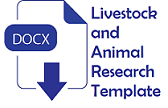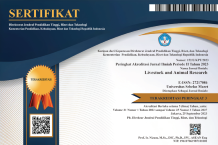Evaluation of primers targeting chromo helicase DNA-binding gene (CHD) for molecular sexing identification in four bird families
Abstract
Objective:
Sex determination of birds is crucial role in breeding and conservation purposes. Genomic approaches by using basis of bird sex polymorphism are accepted to generate an accurate sexing procedure. The PCR method is commonly used and known to provide accurate test results in determining the sex of birds, but its successes is strongly influenced by the compatibility of the primers used with the DNA template. This study aimed to determine the potential use of CHD1LF/CHD1LR targeting CHD gene fragment in 4 species from Phasianidae, Psittacidae, Estrildidae, and Passeridae families.
Method:
Blood samples (n= 30) from representatives of species in 4 families above were collected for DNA isolation, then PCR test was performed using CHD1LF/CHD1LR primers. The PCR results obtained were compared with positive controls, necropsy examination and information from bird sellers.
Result:
The results showed that the primer CHD1LF/CHD1LR could be used in Phasianidae,
Psittacidae, Estrildidae, and Passeridae families. The PCR product was confirmed to be same as well as the positive control and necropsy results. It is demonstrated that male birds showed a single band (474 bp), while double bands (474 and 319 bp) were observed in female birds. Different accuracies were observed during this study between molecular approach and manual sexing by bird seller i.e:
sparrows (46%) and finches (50%), while the accuracy of parakeets was 75%, and quails 80%.
Conclusions:
Primer CHD1LF/CHD1LR can be used to determine the sex of birds from the families
Phasianidae, Psittacidae, Estrildidae, and Passeridae. Our study showed that molecular-based method is valuable and able to reduce error rate to 100% in bird sexing procedures.
Keywords
Full Text:
PDFReferences
- Purwaningrum, M., H. A. Nugroho, M. Asvan, K. Karyanti, B. Alviyanto, R. Kusuma, and A. Haryanto. 2019. Molecular techniques for sex identification of captive birds. Vet. World. 12(9):1506-1513. Doi: 10.14202/vetworld. 2019.1506-1513
- Beeby, A. K. 2021. The use of wing length for sexing Common Chiffchaffs Phylloscopus collybita in a local breeding population. Ringing & Migration. 36(1):23-26. Doi: 10.1080/03078698.2021.2065083
- Lee, J. C. I., L. C. Tsai, P. Y. Hwa, C. L. Chan, A. Huang, S. C. Chin, L. C. Wang, J. T. Lin, A. Linacre, and H. M. Hsieh. 2010. A novel strategy for avian species and gender identification using the CHD gene. Mol. Cell. Probes. 24(1):27-31. Doi: 10.1016/j.mcp.2009.08.003
- Cambrone, C., S. Motreuil, F. O. Reyes, M. A. Landestroy, F. Cézilly, and E. Bezault. 2022. Obtaining DNA samples from sensitive and endangered bird species: A comparison of saliva and blood samples. Ardeola. 69(2):311-326. Doi: 10.13157/arla.69.2.2022.sc1
- Kroczak, A., M. Wołoszyńska, H. Wierzbicki, M. Kurkowski, K. A. Grabowski, T. Piasecki, L. Galosi, and A. D. Urantówka. 2021. New bird sexing strategy developed in the order psittaciformes involves multiple markers to avoid sex misidentification: Debunked myth of the universal DNA marker. Genes. 12(6):878. Doi: 10.3390/genes12060878
- Vera, F., W. Wajjwalku, P. Yuda, and B. S. Daryono. 2011. A new primer set in CHD1 gene for bird sex identification. Biodiversitas. 22(11):4977-4982. Doi: 10.13057/biodiv/d221133
- Sola-Ojo, F. E., N. B. Afolabi-Balogun, C. A. Adeniyi, K. D. Adeyemi, K. L. Ayorinde, O. I. Alli, O. A. Oni, C. U. Okeke, E. O. Momoh, J. Adewara, and I. Abdulkareem. 2021. Molecular sexing and taxonomic classification of Nigerian Guinea Fowl using chromo helicase DNA binding gene and 12S mitochondrial rRNA gene. Journal of Animal Breeding and Genomics. 5(2):59-70. Doi: 10.12972/jabng.20210005
- Savitri, D., I. Putri, W. P. Nugrahani, M. Purwaningrum, and A. Haryanto. 2021. Molecular bird sexing of sulphur‐crested cockatoo (Cacatua galerita) by polymerase chain reaction method. Indones. J. Biotechnol. 26(1):1-6. Doi: 10.22146/ijbiotech.54611
- Xiong, N., W. Tang, T. Mu, and C. Dai. 2021. Sex identification of the ashy-throated parrotbill (Paradoxornis alphonsianus): A species heavily hunted for bird fighting in Guizhou Province, China. Avian Biol. Res. 14(3):92-97. Doi: 10.1177/17581559211013643
- Romanov, M. N., A. M. Betuel, L. G. Chemnick, O. A. Ryder, R. O. Kulibaba, O. V. Tereshchenko, W. S. Payne, Ph. C. Delekta, J. B. Dodgson, E. M. Tuttle, and R. A. Gonser. 2019. Widely applicable PCR markers for sex identification in birds. Russian J. Genet. 55(2):220-231. Doi: 10.1134/ S1022795419020121
- England, A. D., S. K. Kheravii, S. Musigwa, A. Kumar, A. Daneshmand, N. K. Sharma, K. Gharib-Naseri, and S. B. Wu. 2021. Sexing chickens (Gallus gallus domesticus) with high-resolution melting analysis using feather crude DNA. Poult. Sci. 100(3):100924. Doi: 10.1016/j.psj.2020.12.022
- Lois-Milevicich, J., R. O. Gómez, C. A. Ursino, N. A. Lois, and A. De la Colina. 2021. Rapid and low-cost molecular sexing of a corvid songbird using a single protocol with two universal primer sets. Ardeola. 68(2):423-432. Doi: 10.13157/arla.68.2.2021.sc1
- Griffiths, R., M. C. Double, K. Orr, and R. J. Dawson. 1998. A DNA test to sex most birds. Molecular Ecology. 7(8):1071-1075. Doi: 10.1046/j.1365-294x.1998.00389.x
- Kahn, N. W., J. St. John, and T. W. Quinn. 1998. Chromosome-specific intron size differences in the avian CHD gene provide an efficient method for sex identification in birds. The Auk. 115(4):1074-1078. Doi: 10.2307/4089527
- Fridolfsson, A. K. and H. Ellegren. 1999. A simple and universal method for molecular sexing of non-ratite birds. J. Avian Biol. 30(1):116-121. Doi: 10.2307/3677252
- Van der Velde, M., O. Haddrath, Y. I. Verkuil, A. J. Baker, and T. Piersma. 2017. New primers for molecular sex identification of waders. Wader Study. 124(2):147-151. Doi: 10.18194/ws.00069
- Green, M.R. and J. Sambrook. 2019. Polymerase chain reaction. Cold Spring Harb. Protoc. Doi: 10.1101/pdb.top095109
- Ciorpac, M., R. C. Druica, G. Ghiorghita, D. Cojocaru, and D. L. Gorgan. 2016. CHD genes: a reliable marker for bird populations and phylogenetic analysis? Case study of the superfamily Sylvioidea (Aves: Passeriformes). Turk. Zool. Derg. 40(5):749-757. Doi: 10.3906/zoo-1510-22
- Kulibaba, R. O. and Y. V. Liashenko. 2021. Analysis of CHD gene Polymorphism as a model object for molecular 0sexing of Eurasian Eagle-Owl (Bubo bubo). Cytology and Genetics. 5(4):324-330. Doi: 10.3103/ S0095452721040071
- Fitriana, F., R. Resita, Y. Disastra, G. H. Alfatik, C. A. Artdita, A. Haryanto, dan F. Aziz. 2022. Komparasi lima jenis primer polymerase chain reaction untuk mengidentifikasi kelamin burung famili Columbidae yang akurat. Jurnal Sain Veteriner. 40(2):205-220. Doi: 10.22146/jsv.68787
- Liang, S., M. Chen, C. Gao, H. Yan, G. Zhang, and X. Wang. 2019. Sex identification of pigeons using polymerase chain reaction analysis with simple DNA extraction. Avian Biol. Res. 12(2):45-48. Doi: 10.1177/1758155919832141
- Disastra, Y. 2021. Validasi jenis kelamin burung famili Columbidae dari informasi penjual dibandingkan dengan Polymerase Chain Reaction (PCR) dan nekropsi. Proyek Akhir. Program Studi Teknologi Veteriner. Sekolah Vokasi, Universitas Gadjah Mada.
- Latumahina, F. S., C. M. Wattimena, A. M. Sahusilawane, E. Kembauw, M. Tjoa, H. Lelloltery, dan T. D. Cahyono. 2020. Pengelolaan hutan untuk kemakmuran masyarakat pulau-pulau kecil di Maluku. Deepublish, Yogyakarta.
- Vucicevic, M., M. Stevanov‐Pavlovic, J. Stevanovic, J. Bosnjak, B. Gajic, N. Aleksic, and Z. Stanimirovic. 2013. Sex determination in 58 bird species and evaluation of CHD gene as a universal molecular marker in bird sexing. Zoo. Biol. 32(3):269-276. Doi: 10.1002/zoo.21010
- Pamulang, Y. V., and A. Haryanto. 2021. Molecular bird sexing on kutilang (Pycnonotus sp.) based on amplification of CHD-Z and CHD-W genes by using polymerase chain reaction method. Biodiversitas. 22(1):449-452. Doi: 10.13057/biodiv/d220155
- Mazzoleni, S., P. Němec, T. Albrecht, P. Lymberakis, L. Kratochvíl, and M. Rovatsos. 2021. Long‐term stability of sex chromosome gene content allows accurate qPCR‐based molecular sexing across birds. Mol. Ecol. Resour. 21(6):2013-2021. Doi: 10.1111/1755-0998.13381
- Gebhardt, K. J. and L. P. Waits. 2008. High error rates for avian molecular sex identification primer sets applied to molted feathers. J. Field Ornithol. 79(3):286-292. Doi: 10.1111/j.1557-9263.2008.00175.x
- Çakmak, E., Ç. Akın Pekşen, and C. C. Bilgin. 2017. Comparison of three different primer sets for sexing birds. J. Vet. Diagn. Invest. 29(1):59-63. Doi: 10.1177/1040638716675197
- Huang, H. W., Y. F. Su, C. T. Yao, Y. C. Hung, C. C. Chen, C. C. Cheng, S. L. S. Li, and H. W. Chang. 2011. High-throughput gender identification of three Columbidae species using melting curve analysis. Theriogenology. 75(1):73-79. Doi: 10.1016/j/.theriogenology.2010.07.012
mso-fareast-font-family:"Times New Roman";mso-ansi-language:EN-US;mso-fareast-language:
EN-US;mso-bidi-language:AR-SA'>
Refbacks
- There are currently no refbacks.










